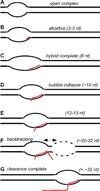Promoter clearance by RNA polymerase II
- PMID: 22982364
- PMCID: PMC3529798
- DOI: 10.1016/j.bbagrm.2012.08.010
Promoter clearance by RNA polymerase II
Abstract
Many changes must occur to the RNA polymerase II (pol II) transcription complex as it makes the transition from initiation into transcript elongation. During this intermediate phase of transcription, contact with initiation factors is lost and stable association with the nascent transcript is established. These changes collectively comprise promoter clearance. Once the transcript elongation complex has reached a point where its properties are indistinguishable from those of complexes with much longer transcripts, promoter clearance is complete. The clearance process for pol II consists of a number of steps and it extends for a surprisingly long distance downstream of transcription start. This article is part of a Special Issue entitled: RNA polymerase II Transcript Elongation.
Copyright © 2012 Elsevier B.V. All rights reserved.
Figures

Similar articles
-
Gdown1 Associates Efficiently with RNA Polymerase II after Promoter Clearance and Displaces TFIIF during Transcript Elongation.PLoS One. 2016 Oct 7;11(10):e0163649. doi: 10.1371/journal.pone.0163649. eCollection 2016. PLoS One. 2016. PMID: 27716820 Free PMC article.
-
Signaling pathways differentially affect RNA polymerase II initiation, pausing, and elongation rate in cells.Mol Cell. 2013 Apr 25;50(2):212-22. doi: 10.1016/j.molcel.2013.02.015. Epub 2013 Mar 21. Mol Cell. 2013. PMID: 23523369 Free PMC article.
-
RNA polymerase II transcription: structure and mechanism.Biochim Biophys Acta. 2013 Jan;1829(1):2-8. doi: 10.1016/j.bbagrm.2012.09.003. Epub 2012 Sep 18. Biochim Biophys Acta. 2013. PMID: 23000482 Free PMC article. Review.
-
The Mediator complex and transcription elongation.Biochim Biophys Acta. 2013 Jan;1829(1):69-75. doi: 10.1016/j.bbagrm.2012.08.017. Epub 2012 Sep 13. Biochim Biophys Acta. 2013. PMID: 22983086 Free PMC article. Review.
-
Eukaryotic core promoters and the functional basis of transcription initiation.Nat Rev Mol Cell Biol. 2018 Oct;19(10):621-637. doi: 10.1038/s41580-018-0028-8. Nat Rev Mol Cell Biol. 2018. PMID: 29946135 Free PMC article. Review.
Cited by
-
Promoter-proximal pausing of RNA polymerase II: a nexus of gene regulation.Genes Dev. 2019 Aug 1;33(15-16):960-982. doi: 10.1101/gad.325142.119. Epub 2019 May 23. Genes Dev. 2019. PMID: 31123063 Free PMC article. Review.
-
Transcription Start Site Scanning and the Requirement for ATP during Transcription Initiation by RNA Polymerase II.J Biol Chem. 2016 Jun 17;291(25):13040-7. doi: 10.1074/jbc.M116.724583. Epub 2016 Apr 17. J Biol Chem. 2016. PMID: 27129284 Free PMC article.
-
Mechanisms and Functions of the RNA Polymerase II General Transcription Machinery during the Transcription Cycle.Biomolecules. 2024 Feb 1;14(2):176. doi: 10.3390/biom14020176. Biomolecules. 2024. PMID: 38397413 Free PMC article. Review.
-
The capping enzyme facilitates promoter escape and assembly of a follow-on preinitiation complex for reinitiation.Proc Natl Acad Sci U S A. 2019 Nov 5;116(45):22573-22582. doi: 10.1073/pnas.1905449116. Epub 2019 Oct 7. Proc Natl Acad Sci U S A. 2019. PMID: 31591205 Free PMC article.
-
Negative elongation factor regulates muscle progenitor expansion for efficient myofiber repair and stem cell pool repopulation.Dev Cell. 2021 Apr 5;56(7):1014-1029.e7. doi: 10.1016/j.devcel.2021.02.025. Epub 2021 Mar 17. Dev Cell. 2021. PMID: 33735618 Free PMC article.
References
-
- Orphanides G, Lagrange T, Reinberg D. The general transcription factors of RNA polymerase II. Genes Dev. 1996;10:2657–2683. - PubMed
-
- Roeder RG. The role of general initiation factors in transcription by RNA polymerase II. Trends Biochem. Sci. 1996;21:327–335. - PubMed
-
- Kostrewa D, Zeller ME, Armache KJ, Seizl M, Leike K, Thomm M, Cramer P. RNA polymerase II-TFIIB structure and mechanism of transcription initiation. Nature. 2009;462:323–330. - PubMed
Publication types
MeSH terms
Substances
Grants and funding
LinkOut - more resources
Full Text Sources
Other Literature Sources

